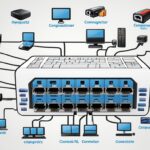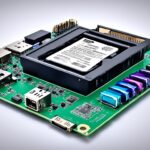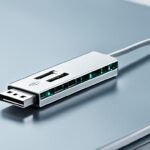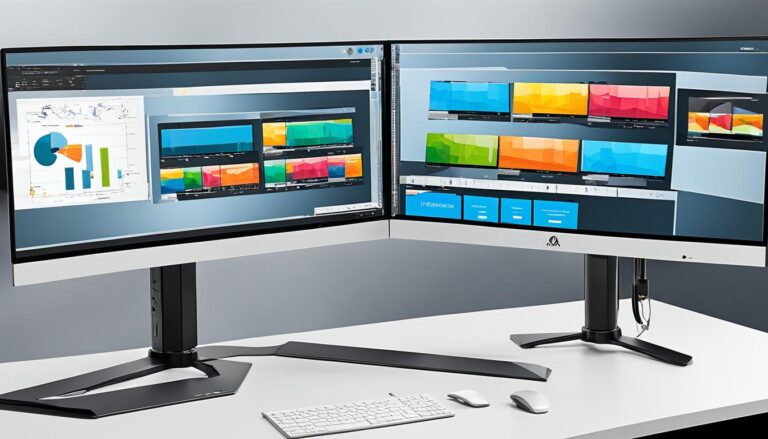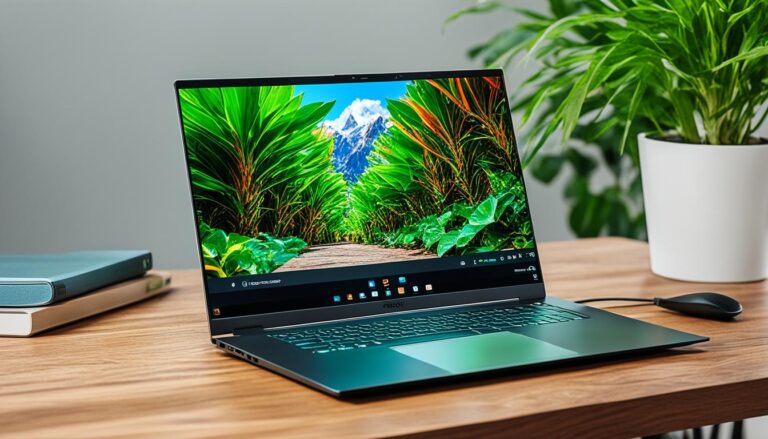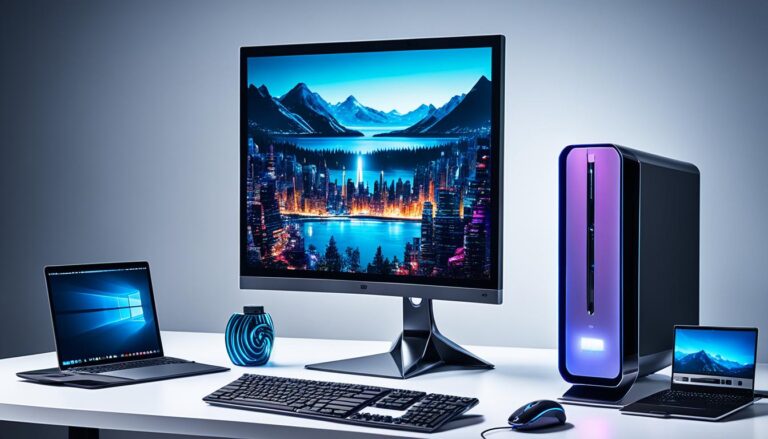A network COM port is also known as a communications port or serial port. It is a hardware interface on computers. It lets devices like printers, modems, and scanners connect to the computer. This makes communication and data transfer possible between them.
The network COM port communicates through a set of pins. These include transmit (TX), receive (RX), and ground (GND). Also, there are control lines. Different communications ports exist, like RS-232 and parallel ports. Yet, USB ports are more common now. Still, in some industries, these ports are vital for connecting older equipment or special devices.
Languages such as Python, C/C++, Java, and .NET can work with these ports. They help in controlling devices and exchanging data.
What are Communications (COM) Ports?
Communications ports, also known as COM ports, are interfaces found on computers. They let computers connect with external devices like printers and scanners for data sharing. These ports use various pins for data to flow between the computer and the devices.
These interfaces are key in linking a computer with external tools. By connecting a device to a COM port, data is shared, aiding in effective communication. They are vital across many sectors, like manufacturing and telecoms, for serial communication.
Communications ports are gateways for device and computer communication. They standardize serial communication, making device compatibility simpler and data transfer less complex.
How Communications Ports Work
Communications ports use pins to share data between computers and devices. The transmit (TX) pin sends data out, while the receive (RX) pin takes data in. Ground (GND) and control lines ensure the data transfer is smooth.
When the computer sends out data, it goes through the transmit pin to the device. The device’s receive pin gets this data and turns it back into useful information. This two-way communication allows for efficient data sharing.
Types of Communications Ports
Different communications ports have different uses. RS-232 ports, for example, have a 9-pin connector. In contrast, parallel ports use a 25-pin connector. But, newer technologies have made these less common in new computers.
Now, USB ports are the main way to connect devices to computers. They’re faster, work with more devices, and can handle multiple connections at once. USB ports have become essential in connecting external devices to computers.
Here’s a table comparing RS-232 ports, parallel ports, and USB ports:
| Port Type | Connector Type | Data Transfer Rate | Compatibility |
|---|---|---|---|
| RS-232 Port | 9-pin connector | Low | Limited to specific devices |
| Parallel Port | 25-pin connector | Medium | Limited to specific devices |
| USB Port | Various types (e.g., Type A, Type C) | High | Wide range of devices |
The image shows how communications ports link computers with external devices for data sharing.
Next, we will look at how modern computers use communications ports. We’ll also dive into programming for these ports.
How Do Communications Ports Work?
Communication ports are vital for data sharing between computers and devices. They make sure communication flows smoothly. Knowing how they work helps understand the complex data sharing process.
These ports have pins that help in sending and receiving data. For data to be sent, it’s turned into bits. These bits go through the transmit (TX) pin to the device. The device gets these bits via the receive (RX) pin. It then uses the data as needed.
To keep the connection stable and control data flow, these ports have ground (GND) and control pins. These pins are key for a stable and quick data path between computers and devices.
The transmit, receive, ground, and control pins work together in communication ports. They make sure data flows well between the computer and devices. This way, data sharing is fast and precise.
Understanding communication ports shows their importance in technology today. They connect devices like printers, scanners, and modems. Thus, they are crucial for communication across many fields and uses.
Types of Communications Ports
In the past, there were mainly two types of communication ports used: RS-232 ports and parallel ports. RS-232 ports have a 9-pin connector, while parallel ports use a 25-pin connector. These ports played a key role in connecting devices to computers, making data transfer possible.
As technology progressed, USB ports became more common in new computers. USB ports, or universal serial bus ports, have some big advantages. They transfer data faster and can connect with many different devices. This made them the preferred choice for modern computers.
To give you a visual comparison, here’s a table summarizing the key features and differences between these types of communications ports:
| Port Type | Connector | Data Transfer Speed | Compatibility |
|---|---|---|---|
| RS-232 Ports | 9-pin connector | Lower transfer speeds | Commonly supported by legacy devices |
| Parallel Ports | 25-pin connector | Medium to high transfer speeds | Commonly used for printers and older devices |
| USB Ports | Various connector types (such as Type-A, Type-C) | High transfer speeds | Widely compatible with modern devices |
The table shows that USB ports are better in speed and compatibility. They are the best choice for today’s computers. But, RS-232 and parallel ports are still used in some cases, especially with old devices and in certain industries.
Next, we’ll look into how these ports are used today and explore other ways to connect devices.
Usage of Communications Ports on Modern Computers
Many modern computers still have at least one communications port. This could be a serial port or an RS-232 port. These allow computers to connect to external devices smoothly. They make data transfer quick and easy. If a computer doesn’t have these ports, a USB-to-serial adapter can help.
USB-to-serial adapters make it easy to connect devices that need serial communication. They turn a USB port into a communications port. This is helpful for computers without these built-in ports. With these adapters, computers can work with printers, modems, and scanners.
Using a USB-to-serial adapter is simple. First, you connect the adapter to a USB port on your computer. This makes that USB port act like a communications port. The adapter takes care of any needed changes to make sure things work together well.
Benefits of USB-to-Serial Adapters:
- Enables communication with external devices requiring serial communication
- Provides an affordable and convenient solution for computers without built-in communications ports
- Supports a wide range of devices, including legacy and specialized equipment
- Easy installation and setup process
- Offers high data transfer rates for efficient and reliable communication
USB-to-serial adapters are important for those who need communications ports but don’t have the right hardware. They ensure that modern computers can connect and talk to external devices smoothly. This means easy connectivity, quick data transfer, and reliable communication.
| Serial Device | USB-to-Serial Adapter Model |
|---|---|
| Printer | USB to RS-232 Adapter |
| Modem | USB to Serial Cable |
| Scanner | USB to DB9 Adapter |
Interacting with Communications Ports
Communicating with external gadgets requires the use of programming languages. Languages like Python, C/C++, Java, and .NET are key in using communications ports. They give developers the tools to manage and swap data with devices that are connected.
Developers can harness libraries and APIs to write code for communications ports. This lets them control devices and share data. It’s about making tasks easier.
“Communications ports serve as gateways for seamless integration between software and hardware. Programming languages empower developers to unlock the full potential of these ports, enabling efficient device control and smooth data exchange.”
Python
Python is a flexible and popular language. It has libraries like pySerial and pyParallel for easy communications port chat. These tools help developers connect, send commands, and get data back.
C/C++
C/C++ lets developers work closely with hardware. Libraries like the Windows API and POSIX API are used. They make the most of communications ports for custom projects.
Java
Java also helps with communication ports. The javax.comm package is a tool for this. Java developers can start connections, send info, and receive updates using it.
.NET
The .NET framework has the System.IO.Ports namespace for talking to ports. This is great for developers using C# or Visual Basic. It makes communication easier.
Using programming languages for communications ports adds flexibility. Developers can send commands, receive info, or make new protocols. This leads to better control of devices and smooth data sharing.
Limitations and Alternative Connectivity Options
Communications ports are key for sending data but fall short with audio and video. For these, HDMI, DisplayPort, or USB are preferred. They offer better quality and compatibility for seamless audio and video experiences.
Usually, communications ports mean wired connections, needing cables to link devices. But wireless connectivity is growing fast. Wireless adapters and Bluetooth offer a cable-free way to connect devices, making them more convenient.
Sometimes, physical communications ports are not an option. Then, software can create virtual serial ports on computers. This helps developers and users alike, making connectivity flexible without needing hardware.
To conclude, communications ports have their limits, especially for audio/video and needing wires. However, alternatives like HDMI, DisplayPort, USB, wireless adapters, Bluetooth, and emulation software make connecting devices easier and more versatile.
Conclusion
A network COM port is crucial for device communication. It links computers to external gadgets, allowing for smooth data sharing. Modern computers often use USB ports, but other kinds like RS-232 also play a big role.
To include communications ports in computers, you can use built-in ones or USB-to-serial adapters. This helps keep devices that need serial communication connected. Languages like Python and .NET let developers manage these ports for better device control and data sharing.
Even though COM ports struggle with audio/video and wireless, they are still vital. Industries like industrial automation and telecommunications rely on them. They’re especially important for older equipment or devices needing serial communication. This shows how essential network COM ports are for connecting different devices across many fields.
FAQ
What is a network COM port?
A network COM port is also known as a serial port. It’s a part of the computer where you plug in things like printers. This port helps these gadgets talk to the computer.
How do communications ports work?
These ports use pins to send and receive data. They change data into bits and send it through a pin. Another device gets these bits and understands them. There are also special lines that help with grounding and controlling the data transfer.
What are the types of communications ports?
Mainly, there are RS-232 and parallel ports. RS-232 ports have a 9-pin connector, while parallel ports have a 25-pin one. Nowadays, USB ports are more common and used in most computers.
How are communications ports used on modern computers?
Even today, computers have at least one serial port. If there’s no built-in port, you can use a USB-to-serial adapter. This way, you can still connect devices that need a serial port.
How can programming languages interact with communications ports?
Languages like Python, C/C++, Java, and .NET have special tools. These tools let developers control devices through the ports. They can write code to manage devices and swap data with them.
What are the limitations and alternative connectivity options for communications ports?
Communications ports are for data, not audio or video. For audio/video, you use HDMI, DisplayPort, or USB. For wireless, use network adapters or Bluetooth. You can also make virtual ports with software if needed.




